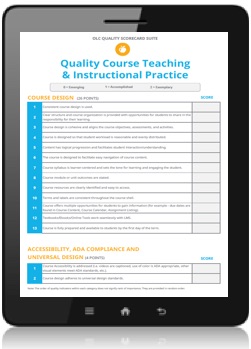Course Review
Quality Course Teaching and Instructional Practice (QCTIP)
The Quality Course Teaching and Instructional Practice (QCTIP) scorecard is a comprehensive rubric which can be used for an in-depth review to validate instructional practices as compared to quality standards identified by our panel of experts.
Home > Consulting > Quality Scorecards > Quality Scorecards > Quality Course Teaching and Instructional Practice

The Quality Course Teaching and Instructional Practice (QCTIP) scorecard is a comprehensive rubric which can be used for an in-depth review to validate instructional practices as compared to quality standards identified by our panel of experts.
Designed to evaluate the overall classroom experience, this tool can be used to evaluate teaching effectiveness in several areas, including: Course Fundamentals, Learning Foundations, Faculty Engagement and Student Engagement.
Institutions can pursue a third-party, independent course review through the OLC Course Review services. Those that achieve exemplary status may be eligible to display an OLC Exemplary Course logo in their course.
A free version of the Quality Course Teaching and Instructional Practice (QCTIP) Scorecard is also available to download.
Contact sales@onlinelearning-c.org to learn more about how your institution can benefit from a Program Review.
The QCTIP Scorecard can also be used independently in several different areas:
Use this scorecard to evaluate quality in course design, ensure an effective classroom experience before the session starts and for post-course evaluation.
Use this scorecard to ensure that key quality learning components are incorporated in the digital course to create an effective learning environment for students.
Use this scorecard to evaluate areas like course learning outcomes, course content, and assignments and the critical steps that should be taken to improve the student learning experience.
Use this scorecard to ensure a quality learning experience for your students by following the identified steps required to create an engaging and effective classroom environment.
